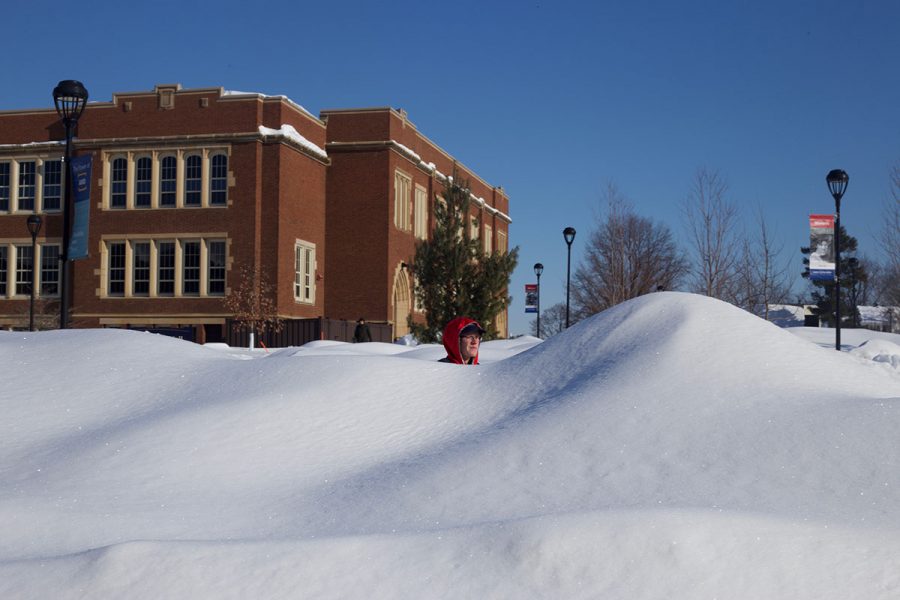Record snowfall could lead to severe flooding
Experts speak on the likelihood of flooding in Eau Claire and what residents can do to be prepared
Photo by Gabbie Henn
Due to this month’s record amounts of snow, the chance for the Chippewa River to meet major flood stage is 30 percent, up from a typical likelihood of just 5 percent.
With February being Eau Claire’s all-time snowiest month on record — according to data reported by WEAU-13 News — the city could be facing severe flooding this spring.
Eau Claire County Emergency Management Division Coordinator Tyler Esh said there is a significantly higher than normal chance of flooding this spring. The chance for the Chippewa River to meet major flood stage is 30 percent, up from a typical likelihood of just 5 percent.
Esh said these higher risks are the result of not only large amounts of snow but also other environmental factors.
“The risk has to do with the record snowfall,” Esh said. “Additionally, before the snow started last fall, the summer was pretty wet. There was lots of moisture to begin with, so the ground is pretty much at consumption. A third aspect is the frost level. Right now it’s three feet deep.”
Doug Faulkner, a fluvial geomorphologist — or river scientist — and professor of geography and anthropology at UW-Eau Claire, said that due to the large amounts of snow on the ground both in Eau Claire and to the north of the city, the possibility of flooding occurring is increased, but not definite.
“A 500 year flood is improbable, but it’s not impossible,” Faulkner said. “We could suddenly get a big flow of warm air here — advection — which would cause a rapid melt. That would be bad enough, but also when that happens at this time of the year we often get spring thunderstorms. If we get rapid warming with rain, on top of snow, we could get a catastrophic flood.”
In his class on the science of rivers, Faulkner said he teaches his students the same lesson his PhD advisor once gave to him.
“He used to say to us, ‘Nature’s priming the pump,’” Faulkner said. “And right now, the conditions are kind of getting set for a big flood. The pump is really primed right now.”
In the case of flooding, Esh said the city of Eau Claire has different procedures they take to keep residents safe. Different low-lying trails are shut down as river levels rise and if flooding becomes too significant, the city has an idea of where flooding would occur and has the procedures set to work out evacuations.
In addition to heeding to city notices, there are several other measures residents can take into consideration to keep themselves safe from floodwaters.
“The biggest thing residents can do to stay safe in the case of flooding is maintain gas in their vehicles,” Esh said. “This is so if we have to evacuate you, you’re able to get in your vehicle and go somewhere. Make sure you have stuff you need to get away at a moment’s notice.”
Additionally, Esh said there were a few actions people can take to potentially reduce the water damage in their homes.
“A couple good practices would be, if possible – and I know this is not an easy task – to push snow away from the foundation of your house,” Esh said. “Especially to a spot where it would drain away from your house. And if you have valuables in your basements, make sure they are not on the floor and in protected places or storage containers.”
As for UW-Eau Claire itself, Faulkner said the campus would most likely be safe in the case of high floodwaters. This is in part due to the high elevation of much of the buildings on campus.
“The areas that would be flooded are very minimal,” Faulkner said. “The area along the creek is low, so when the river gets high, the river would sort of flood back up along the little Niagara Creek, and it might even go a little up into the park during flooding times.”
Over time, UW-Eau Claire has also put several measures in place in order to keep the more “at-risk” buildings safe from flood waters. These measures include a pump and dam system beneath Garfield Hill, and the raising of Garfield Avenue during its recent reconstruction, Faulkner said.
“That’s not to say a really catastrophic flood couldn’t get up and get more of campus,” Faulkner said. “But it would be a really rare flood, in fact, it would be a bigger flood than anyone’s ever seen, that is any European Americans have seen since coming here.”
Faulkner said while students have typically shown to have respect for the Chippewa River, they should be particularly careful in the case of flooding.
“If the river does get out of its channel in places, folks just have to be smart because it doesn’t take much velocity of water or much depth to sweep people off their feet,” Faulkner said. “So, if we do start getting some out of bank flows, people need to think wisely. Water can be more dangerous than people think.”
For the latest tips and updates on flooding and severe events in Eau Claire, residents can follow the Eau Claire County Management Division on Facebook and Twitter.
Kopke can be reached at kopkelg3003@uwec.edu.

Lea Kopke is a fourth-year journalism and German student. This is her seventh semester on The Spectator staff. She plays the clarinet in the Blugold Marching Band and recently relearned how to ride a bike with no hands.


